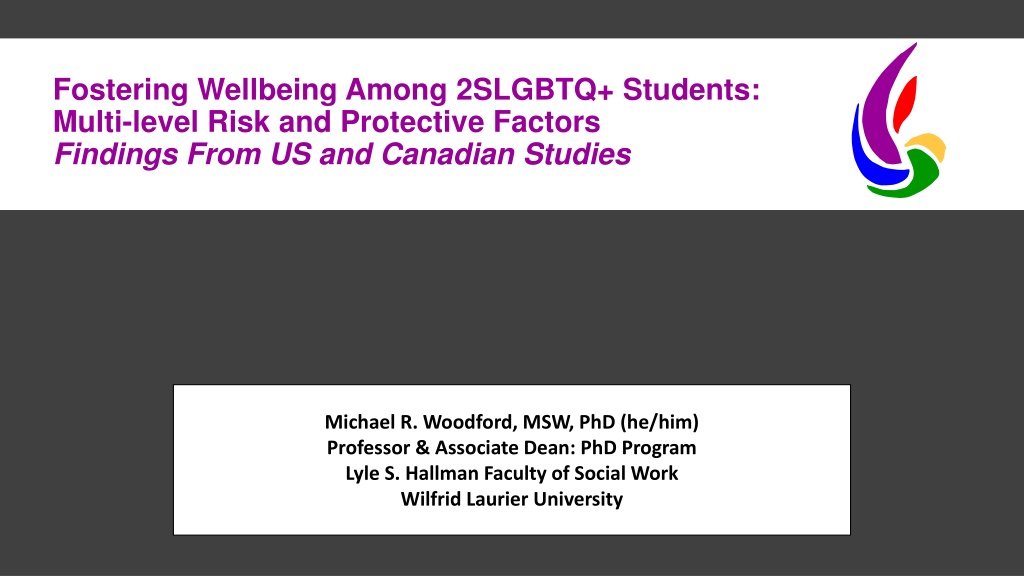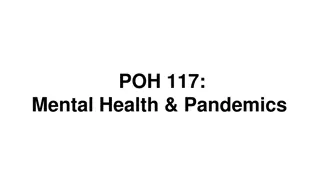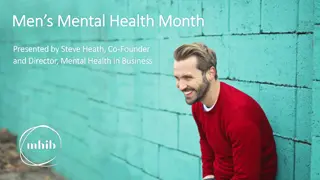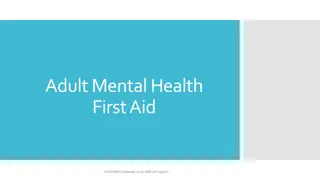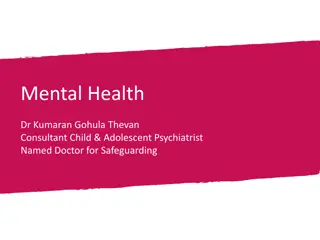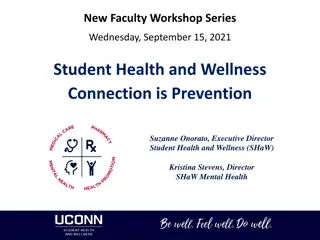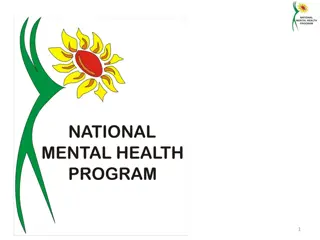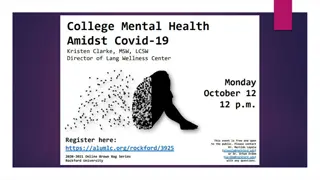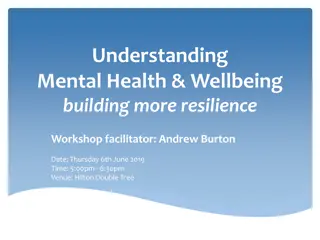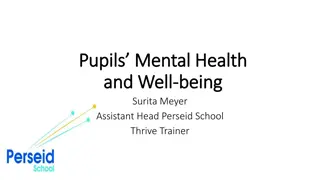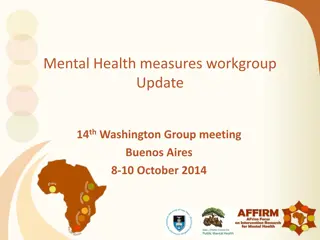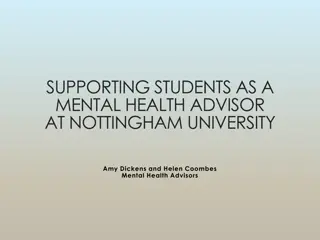Understanding Mental Health Challenges Among 2SLGBTQ+ Students
Explore the complexities of mental health issues faced by 2SLGBTQ+ students through a multi-level analysis of risk and protective factors. Research highlights disparities in mental health outcomes compared to cisgender heterosexual peers, showcasing higher rates of anxiety, depression, suicidal ideation, and lower levels of flourishing. Trans students and those with intersecting marginalized identities experience heightened vulnerabilities, emphasizing the need for targeted support and intervention strategies.
Download Presentation

Please find below an Image/Link to download the presentation.
The content on the website is provided AS IS for your information and personal use only. It may not be sold, licensed, or shared on other websites without obtaining consent from the author. Download presentation by click this link. If you encounter any issues during the download, it is possible that the publisher has removed the file from their server.
E N D
Presentation Transcript
Fostering Wellbeing Among 2SLGBTQ+ Students: Multi-level Risk and Protective Factors Findings From US and Canadian Studies Michael R. Woodford, MSW, PhD (he/him) Professor & Associate Dean: PhD Program Lyle S. Hallman Faculty of Social Work Wilfrid Laurier University
Students Mental Health A Growing Crisis in Canada & Beyond
Students Mental Health A Growing Crisis Mental Health Commission of Canada Speaking up about student mental health, May 5, 2022 To say I was not fully prepared for post-secondary studies is an understatement. It was not a question of intelligence or academic ability. It had more to do with my mental health and lack of support. Yet against all odds, I was successful and graduated from university. How did I manage to complete my degree? Sheer grit and determination. The fact is that not all students come to the post-secondary journey on equal footing. Research shows that 2SLGBTQ+ students experience poorer mental health than their cisgender heterosexual counterparts In the US, approximately 1 in 5 queer spectrum (LGBTQ+) university students report they had seriously considered suicide during the previous 12 months 3x the rate of their heterosexual and cisgender counterparts (Greathouse et al., 2018)
Percentage of Students Reporting Mental Health Challenges & Flourishing % 60 50 40 30 20 10 0 Diagnosed with anxiety Diagnosed with depression Seriously considered suicide Attempted suicide Flourishing (positive mental health) LGBT+ (n = 6143) Cisgender Heterosexual (n = 33845) Woodford, Coulombe, Marshall, Schwabe, Krzesni, & Canadian Centre for Gender & Sexual Diversity
Trans Students Are Particularly Vulnerable Percentage of Trans Students & Cisgender LGB+ Students Reporting Mental Health Challenges & Flourishing 40.0 35.0 30.0 25.0 20.0 % 15.0 10.0 5.0 0.0 Diagnosed with anxiety Diagnosed with depression Seriously considered suicide Attempted suicide Flourishing (positive mental health) Trans (n = 1067) Cisgender LGB+ (n = 5071)
Intersecting identities and Mental Health Differences among LGBT+ Students LGBT+ students living with disabilities (vs. no disability) LGBT+ racialized students (vs. white) Higher rates of attempted suicide Lower rates of flourishing Higher rates considered suicide attempted suicide anxiety and depression diagnoses Lower rates of flourishing
Minority Stress Theory Hendricks & Testa, 2012; Meyer, 1995; 2003 Context: Heterosexism & Cisgenderism Protective Factors (Individual & Community) General Stressors Distal Minority Stressors Proximal Minority Stressors Mental Health Outcomes Inclusion & Support Points in the boxes represent opportunities for intervention (prevention of stressors & resilience to stressors)
Negative Campus Climate as a Minority Stressor Impacting Mental Health Among LGBQ students Victimization increased risk for psychological distress, suicidality, & substance use problems (Reed et al., 2010; Waldo et al, 1998) Heterosexist harassment & incivility increased risk for anxiety, depression, & problematic drinking (Silverschanz et al. 2008; Woodford, Han et al., 2014; Woodford, Kulick et al. 2014) LGBQ microaggressions increased risk for depression & attempted suicide (Woodford et al., 2018) Among trans students Victimization increased risk for attempted suicide Trans microaggressions increased risk for depression (Woodford et al., 2018) Not having access to comfortable bathrooms & lack of gender inclusive housing lower social acceptance (Woodford et al., 2017)
Toward A Comprehensive Perspective Existing research is heavily focused on negative indicators, providing an incomplete perspective of 2SLGBT+ students mental health Optimal Complete Mental Health Model (Keyes, 2002, 2005) Mental Health Challenges Positive mental health Anxiety Depression Positive Mental Health Life satisfaction Mental health challenges Self-acceptance Social contribution (Keyes, 2002, 2005)
Experiences of Minority Stressors Underlying LGBT+ Students Mental Health In turn, associated with - higher odds of (1) being diagnosed with depression* (2) attempted suicide* - lower flourishing** Associated with LGBT+ - Higher rates of victimization (vs. cisgender heterosexual) -Lower feelings of safety *Past year ** Past month
Promoting the acceptance, wellbeing, and academic development of 2SLGBTQ2S university students throughout Ontario
Lets Look at the Climate Victimization & Incivility Trans & LGBQ Microaggressions From Thriving On Campus - 2SLGBTQ+ Campus Climate: Students Experiences on & Perceptions of Campus
Expectations of Discrimination Because of my LGBQ/trans identity I worry LGBQ Trans (n = 3511 3514) (n = 807 813) Stared at or whispered about 51% 56% Avoid talking/working with me 42% 53% Verbally insulted/threated 47% 55% Personal property damaged/destroyed 18% 30% Physically assaulted 30% 42% Sexually assaulted 32% 39% Bullied online 28% 45%
Climate (cont) Perceptions of the climate For most aspects of the perceived climate, students reported perceptions on the positive side of the scale, however these perceptions remained very close to neutral. From Thriving On Campus - 2SLGBTQ+ Campus Climate: Students Experiences on & Perceptions of Campus
Mental Health & Protective Indicators Psychological distress Depression & anxiety (past 2 weeks) Significant differences were found based on gender identity across 5 groups highlighting diversity among trans students Positive mental health (past month) Emotional, social, & psychological wellbeing E.g., satisfaction with life, feel you had something to important to contribute to society, experiences that challenged you to grow and become a better person Gender groups: Non-binary+, trans woman spectrum, trans man spectrum, cisgender woman, cisgender man
Intersections of Climate & Mental Health Relationships found to be statistically significant: Students who reported greater discrimination tended to report higher distress and lower positive mental health Climate Indicator Trans Students Cisgender LGBQ Students Distress Positive MH Distress Positive MH Victimization NS NS Incivility NS Interpersonal microaggressions NS Environmental microaggressions NS NS NS Note: Many of the statistically not significant relationships were approaching p < .05 Analyses included age, undergraduate/graduate, disability, and race; NS = not significant
Intersections of Climate & Mental Health (con t) Relationships found to be statistically significant: Students who reported greater perceptions of an affirming 2SLGBTQ climate tended to report lower distress and greater positive mental health Climate Indicator Trans Students Cisgender LGBQ Students Distress Positive MH Distress Positive MH Collective attitudes & treatment NS NS Diversity, equity & inclusion policies NS NS NS NS Intuitional leadership NS NS Not worrying about being mistreated Analyses included age, undergraduate/graduate, disability, and race; ; NS = not significant
Resilience Factors Manifestion of positive functioning despite adverse situations, promoted by factors at multiple levels: Personal resilience trait Social support Policies, services, and resources Schmitz & Tyler (2019); Woodford et al. (2018a, b),
Socio-Ecological Protective Factors: US-based findings from qualitative & quantitative studies Individual Level Interpersonal Structural Inclusive policies** LGBTQ centres & groups** Inclusive facilities & resources (e.g. housing) Involvement in LGBTQ campus activities* Self-acceptance Self-esteem* Physical exercise* Resilience LGBTQ friends* Positive peer relations* Instructor relations LGBTQ affirming faculty Trans kinship Connectedness * Moderated minority stressors ** Lower levels of discrimination Busby et al (2019); Bissonette & Szymanski, 2019; Nicolazzo, Pitcher, Renn, & Woodford, 2017; Pitcher, Camacho, Renn, & Woodford, 2018; Woodford, Kulick, et al., 2014; Woodford et al., 2018
Promising results from Thriving The more 2SLGBTQ+ faculty/staff known Cisgender LGBQ students: Protect against the negative effects of poor perceptions of LGBQ collective attitudes & institutional leadership, & worrying about safety on positive mental health Next steps Other potential protective factors Intersecting identities & subgroups among 2SLGBTQ+ students
The Need for Equitable & Responsive Services I was seeing a counsellor back in my first year and as soon as I mentioned I was queer, he was like, that s why you re depressed. And I was like, I don t think so, I m very comfortable with my identity and he was like, no, you ll figure it out you ll come to that conclusion yourself. Trans, nonbinary, queer, white, disabled, undergraduate student Students who provided a positive evaluation of psychological/mental health services by gender Nonbinary Students Trans Students Cisgender Students Felt welcomed and respected 77.9% 83.3% 86.0% Staff knowledgeable about needs 61.3% 69.4% 75.0% Staff skilled in providing services 69.1% 64.9% 73.6% Overall, satisfied with services 62.7% 70.1% 70.5% From Thriving On Campus Campus Policies, Facilities, & Services
Promoting Mental Health Among 2SLGBTQ+ Students Prevention Treatment Inclusion/Exclusion Support & Belonging Mental Health Services Formal support o Support groups o Centres/groups Informal Support o Peer support o Social groups 2SLGBTQ+responsive Commitment all levels Staff training Staff supervision Performance appraisal Promotion & outreach Policy Awareness & education Peer relations Faculty relations
Developing Equitable & Responsive Services Understand determinants of health & the context in which 2SLGBTQ+ students live/study Understand how discrimination & its internalization can affect 2SLGBTQ+ wellbeing Be knowledgeable about (& advocate for) 2SLGBTQ+ resources Recognize intersectional identities (e.g., race, disability) that may alter the experiences of 2SLGBTQ) students Increase capacity to provide inclusive & affirming services to 2SLGBTQ+ students Not assuming students are seeking services related to 2SLGBTQ+ identities Using inclusive language (e.g., gender pronouns for trans clients) Building relationships with 2SLGBTQ+ student groups & community-based service providers Publicize efforts to become inclusive & affirming (moving beyond the rainbow sticker) 2SLGBTQ+ responsive service competencies included in training & performance monitoring systems
Thank you for joining us our public keynote presentations For those registered for the remained of the day, please leave the webinar and join the Zoom Meeting Room in 5 minutes Need the next link? See the provided linktree
Thank you for joining us See you on November 24 Keynote Presentations 9:00 - 9:30 Supporting 2SLGBTQ+ Students to Thrive on Campus Lauren Munro, David Pereira, Brandon R. G. Smith, & Kristin Renn More Than a Checklist: Post-Secondary Wins and Gaps for Trans Inclusion 9:30 - 10:00 Jasper Fisher, Tai Jacob, & Michelle Poirier 1:30 2:00 Promoting Inclusion and Allyhood Safe Space Programming Corey Johnson
